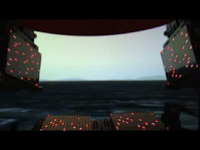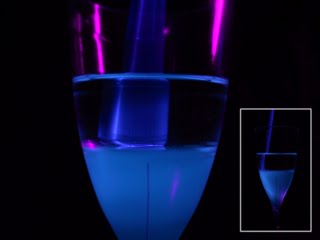Augmented Vection:移動感の増強に関する研究
It is known that peripheral vision strongly contributes to the sense of self-motion, and that users of visual displays with a narrow field of view often findit hard to experience such sensations fully. In thisresearch, we propose a peripheral display thataugments the feeling of self-motion. This consists ofsimple displays that stimulate the user’s peripheralarea of vision. By changing the stimulus on theperipheral display, the system should be able toincrease or reduce the user’s sense of self-motion. Inthis report, we describe a prototype of the displaysystem and the result of its evaluation. 現在,パソコンを含めたゲーム用ハードウェアの普及により,個人が家でゲームを簡単に楽しむことができるようになっています.その一方で課程では,人間に対する感覚情報のフィードバックシステムは限られたものしか利用できないという問題があります.例えばフライトシミュレータのようなものを例にとって考えた場合,コックピット窓からの映像,パネル上の計器類などはディスプレイ上に視覚情報として再現することが可能ですが,その視野角や操縦桿の操作感,機体運動時の加速度感などについては,提示装置が大がかりになることもあり,家庭での実現はハードルが高いのが現状ですこの問題に対して我々は,特に速度感,加速度感を対象として,安価に,且つ簡便に速度感・加速度感の増強提示を可能にするシステムの開発を目指しています.フライトシミュレーションゲームを行う際に速度感・加速度感を増強する事によって,従来よりも実際の航空機操縦時の感覚に近い状態を再現する事が可能になると期待しています.また実際の航空機においても,ヘリコプターによる高々度でのホバリング,あるいは飛行機による横風の下での着陸と言った状況では,パイロットが得られる速度感・加速度感が乏しいことも影響して,操縦の難易度が上がってしまうという問題があります.この時,パイロットの速度感・加速度感を増強して提示する事が可能であるならば,操縦時の負荷軽減,ならびに安全性の向上が可能になると期待されます. Publications: 岡野 裕,橋本 悠希,梶本 裕之,野嶋 琢也:周辺視野選択的な運動知覚を実現する視覚刺激の提案,日本バーチャルリアリティ学会第14回大会予稿集,2009. (PDF) Takuya NOJIMA, Yoshihiko SAIGA, Yu Okano and Hiroyuki KAJIMOTO, “The Sleighing


